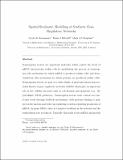Files in this item
Spatial-stochastic modelling of synthetic gene regulatory networks
Item metadata
| dc.contributor.author | Macnamara, Cicely K. | |
| dc.contributor.author | Mitchell, Elaine | |
| dc.contributor.author | Chaplain, Mark A. J. | |
| dc.date.accessioned | 2020-02-10T00:34:57Z | |
| dc.date.available | 2020-02-10T00:34:57Z | |
| dc.date.issued | 2019-05-07 | |
| dc.identifier | 257642004 | |
| dc.identifier | db2bab83-d895-4ce5-9922-4097db2e8856 | |
| dc.identifier | 85061628933 | |
| dc.identifier | 000462102600003 | |
| dc.identifier.citation | Macnamara , C K , Mitchell , E & Chaplain , M A J 2019 , ' Spatial-stochastic modelling of synthetic gene regulatory networks ' , Journal of Theoretical Biology , vol. 468 , pp. 27-44 . https://doi.org/10.1016/j.jtbi.2019.02.003 | en |
| dc.identifier.issn | 0022-5193 | |
| dc.identifier.other | ORCID: /0000-0003-4961-6052/work/54181495 | |
| dc.identifier.other | ORCID: /0000-0001-5727-2160/work/55378841 | |
| dc.identifier.uri | https://hdl.handle.net/10023/19433 | |
| dc.description | Funding: EPSRC Grant No. EP/N014642/1 (EPSRC Centre for Multiscale Soft Tissue Mechanics - With Application to Heart & Cancer) (MAJC,CKM). | en |
| dc.description.abstract | Transcription factors are important molecules which control the levels of mRNA and proteins within cells by modulating the process of transcription (the mechanism by which mRNA is produced within cells) and hence translation (the mechanism by which proteins are produced within cells). Transcription factors are part of a wider family of molecular interaction networks known as gene regulatory networks (GRNs) which play an important role in key cellular processes such as cell division and apoptosis (e.g. the p53-Mdm2, NFκB pathways). Transcription factors exert control over molecular levels through feedback mechanisms, with proteins binding to gene sites in the nucleus and either up-regulating or down-regulating production of mRNA. In many GRNs, there is a negative feedback in the network and the transcription rate is reduced. Typically, this leads to the mRNA and protein levels oscillating over time and also spatially between the nucleus and cytoplasm. When experimental data for such systems is analysed, it is observed to be noisy and in many cases the actual numbers of molecules involved are quite low. In order to model such systems accurately and connect with the data in a quantitative way, it is therefore necessary to adopt a stochastic approach as well as take into account the spatial aspect of the problem. In this paper, we extend previous work in the area by formulating and analysing stochastic spatio-temporal models of synthetic GRNs e.g. repressilators and activator-repressor systems. | |
| dc.format.extent | 3134703 | |
| dc.language.iso | eng | |
| dc.relation.ispartof | Journal of Theoretical Biology | en |
| dc.subject | Synthetic gene regulatory networks | en |
| dc.subject | Repressilators | en |
| dc.subject | Activator-repressor systems | en |
| dc.subject | Spatial modelling | en |
| dc.subject | QA75 Electronic computers. Computer science | en |
| dc.subject | QH301 Biology | en |
| dc.subject | RC0254 Neoplasms. Tumors. Oncology (including Cancer) | en |
| dc.subject | DAS | en |
| dc.subject | SDG 3 - Good Health and Well-being | en |
| dc.subject.lcc | QA75 | en |
| dc.subject.lcc | QH301 | en |
| dc.subject.lcc | RC0254 | en |
| dc.title | Spatial-stochastic modelling of synthetic gene regulatory networks | en |
| dc.type | Journal article | en |
| dc.contributor.sponsor | EPSRC | en |
| dc.contributor.institution | University of St Andrews. Applied Mathematics | en |
| dc.contributor.institution | University of St Andrews. School of Mathematics and Statistics | en |
| dc.identifier.doi | https://doi.org/10.1016/j.jtbi.2019.02.003 | |
| dc.description.status | Peer reviewed | en |
| dc.date.embargoedUntil | 2020-02-10 | |
| dc.identifier.grantnumber | EP/N014642/1 | en |
This item appears in the following Collection(s)
Items in the St Andrews Research Repository are protected by copyright, with all rights reserved, unless otherwise indicated.

